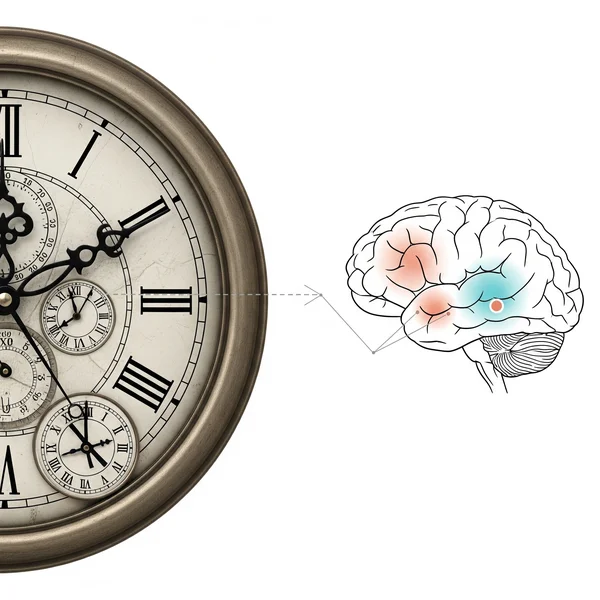为什么读模拟钟很难?以及相关的认知技能
剖析困难:探索阅读模拟钟背后的认知技能及其与计算障碍等学习差异的联系
对许多人来说,看一眼模拟钟并立即知道时间是轻而易举的事。但对其他人来说,这项看似简单的任务可能会成为持续的挫败源。为什么有些人的读模拟钟这么难,甚至成年后也是如此?事实是,解读那些移动的指针涉及 认知技能钟 阅读所需的复杂技能的相互作用。本文将深入探讨所需的特定能力,探讨 认时间困难 的常见原因,并讨论这些挑战如何有时与计算障碍等学习差异相关联。如果您或您认识的人在阅读 读模拟钟困难 显示屏方面遇到重大问题,那么理解根本原因是第一步,而像计算障碍测试这样的资源可以提供宝贵的见解。
不仅仅是数字:复杂的认知技能钟阅读需求

认时间需要哪些认知技能 才能读懂模拟钟?这远不止是识别数字。
空间推理和模拟钟表盘
理解和解释空间关系的能力至关重要。这包括:
- 理解角度和相对位置: 识别时针和分针相对于彼此以及表盘上的数字的位置。
- 视觉空间技能: 在脑海中旋转钟表盘或想象指针的移动。 强大的 空间推理钟 技能对于理解呈现的视觉信息至关重要。
数感和排序技能用于认时间
良好的 数感 至关重要。这包括:
- 五个数的计数: 分针的位置通常需要以五分钟为间隔进行计数(例如,“1”是5分钟,“2”是10分钟)。
- 理解60分钟周期: 知道一小时由60分钟组成,以及小时的分数(如四分之一或二分之一)与之的关系。 强大的 排序技能 有助于按正确的顺序处理这些信息。
视觉处理:区分指针和刻度
有效的 视觉处理钟 技能使个人能够:
- 专注于相关线索: 区分时针和分针(由于大小或设计而可能令人混淆)。
- 过滤干扰: 忽略钟表盘上的装饰元素,专注于重要的计时组件。
- 视觉辨别: 精确地感知单个分钟的小刻度。
工作记忆在保存时间信息中的作用
工作记忆钟 功能对于以下方面至关重要:
- 记住指针位置的同时转换为数字: 保持指针位置的视觉信息,同时检索数字含义。
- 多步骤处理: 例如,看到分针在“8”处,记住这意味着40分钟,看到时针在“3”之前,并将所有这些整合在一起说“2:40”。
方向性和理解顺时针运动
对 方向概念,特别是“顺时针”的基本理解,对于解释指针的运动和时间的推移至关重要。
为什么有些人读模拟钟这么难?常见的难点

理解所需的认知技能有助于我们了解 为什么读模拟钟很难 对某些人来说。以下是常见的困难:
混淆时针和分针
这是一个非常普遍的问题,特别是如果指针的长度或设计相似。时针分针混淆 会导致将时间误读几小时。
难以理解时间的分数(一刻钟后,半小时后)
将“一刻钟后”、“半小时后”或“一刻钟前”等术语转换为特定的指针位置和分钟数,需要理解 时间分数钟 的概念,这可能具有挑战性。
难以将视觉线索转换为数字时间
从看到指针处于特定配置到用数字格式(例如,“7:50”)说出时间,需要顺利整合上述所有认知技能。
多步骤处理方面的挑战
阅读模拟钟不是一个单步骤的任务。它涉及感知、解释、计算(以五个数为单位计数)和整合信息,如果任何潜在技能薄弱,所有这些都可能超载认知资源。
联系:当认时间困难表明学习差异时

持续且严重的 学习困难:认时间 在模拟钟上,特别是当其他年龄合适的技能正在正常发展时,有时可能是潜在学习差异的指标。
计算障碍和对数字概念(包括时间)的挑战
计算障碍是一种特定的学习障碍,会影响个人理解、学习和执行数学和基于数字的操作的能力。由于在模拟钟上认时间很大程度上依赖于 数感、排序和理解数量(如一小时 60 分钟),因此患有计算障碍的个人通常会遇到明显的 认时间困难。模拟钟计算障碍 的联系很强,因为钟表的视觉空间和数字要求可以突出与这种学习差异相关的核心缺陷。这可能是许多 计算障碍症状 之一。
阅读障碍:视觉处理和排序困难的潜在重叠
虽然阅读障碍主要影响阅读和语言技能,但也可能存在一些重叠。一些阅读障碍者也可能在 视觉处理钟 任务或 排序技能 方面遇到挑战,这可能会影响他们阅读模拟钟的能力。需要注意的是,模拟钟阅读障碍 不是一个正式的术语,但这些潜在的认知技能有时可能会在这两种情况下都受到影响。然而,阅读钟表的困难更直接、更常见地与计算障碍有关。
其他视觉空间或处理挑战
非语言学习、视觉运动整合或其他处理速度方面的困难也可能导致难以阅读模拟钟表。认知技能钟 阅读需求很广泛。
如果您或您认识的人难以使用模拟钟,您可以做什么?
成年后难以读懂模拟钟是否正常? 虽然许多人很容易学会,但这肯定不是不正常的,特别是如果存在潜在的认知差异。
耐心、练习和多感官策略
对于一般学习:
- 使用可以移动指针的触觉钟表。
- 使用言语提示和押韵。
- 使用将钟表盘分解成段的视觉辅助工具。 一致的、耐心的练习各种 认时间的策略 可以有所帮助。
寻求理解:何时考虑进行认知技能评估
如果 读模拟钟困难 显示持续存在,造成重大挫败感,并且可能与数学、排序或空间任务中的其他困难同时发生,那么考虑进行 认知技能评估 可能会有益。确定根本原因可以为更有针对性的支持提供帮助。如果这些挑战与您或您认识的人产生共鸣,并且您正在寻求关于潜在计算障碍的清晰度,那么在我们的网站上进行在线计算障碍测试可以成为一个信息丰富的第一步。
理解钟表挑战背后的“原因”
阅读模拟钟是一项令人惊讶的复杂的认知任务,我们许多人认为理所当然。了解复杂的 认知技能钟 阅读需要什么——从 空间推理钟 能力到 数感 和 工作记忆钟 功能——这有助于我们理解 为什么读模拟钟很难 对某些人来说是一个真正的挑战。当这种困难持续且严重时,值得探索与计算障碍等学习差异的潜在联系,不是为了贴标签,而是为了理解并提供适当的支持。
您是否发现模拟钟具有挑战性?什么帮助了你?请在评论中分享您的经验。
关于模拟钟困难的常见问题
成年后难以阅读模拟钟是否正常?
虽然不太常见,但一些成年人确实仍然难以阅读模拟钟。这可能是由于童年时期从未完全掌握这项技能,也可能是由于未确诊的学习障碍或认知处理方面的挑战。
如今有多少人不会读模拟钟?
很难获得确切的统计数据,但根据轶事,随着数字钟表的普及,与前几代人相比,较年轻的人可能不太擅长使用模拟钟表。然而,显著的、持续的无能为力与仅仅缺乏练习是不同的。
模拟钟的困难可能是学习障碍的迹象吗?
是的,持续且严重的 读模拟钟困难,特别是如果已经尝试过其他学习方法,可能是几种 计算障碍症状 之一,或与影响视觉空间处理、排序或数感的其他学习障碍有关。它很少是唯一的迹象,但它可能是一个重要的迹象。
阅读模拟钟的困难和计算障碍有什么区别?
在模拟钟上 认时间困难 可能是计算障碍的一种症状或表现形式。计算障碍是一种更广泛的学习障碍,会影响各种数学和数字能力。如果钟表阅读困难源于与数字相关的核心数感、数量理解或空间推理问题(计算障碍中很常见),那么它就与计算障碍有关。但是,也可能有人由于其他孤立的原因而难以阅读钟表。全面的评估,例如我们网站上提供的计算障碍测试,可以帮助区分和了解更大的图景。